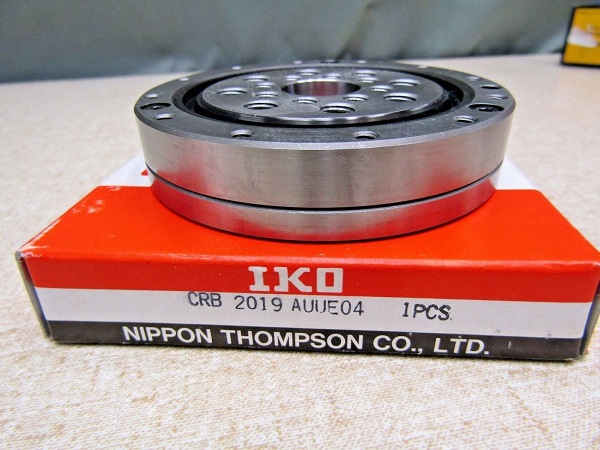Common Faults of IKO Hydrostatic Bearings
Writer: Eric Bearing Limited
In the process of using hydrostatic bearings, some bearing failures are often encountered. Today, Eric Bearing Limited explained the 6 common failures of IKO hydrostatic bearings, as well as the causes and elimination methods of the failures, and hopes to help everyone.
IKO hydrostatic bearing failure 1: Pure liquid lubrication cannot be established
Trouble phenomenon: After the automatic oil pump, if pure liquid lubrication has been established, it should generally be able to rotate easily by hand; if it does not rotate or is more difficult to rotate than when no oil is supplied, it means that pure liquid lubrication has not been established. If you are looking for IKO CRB 2019 AUUE04 Holed Cross Roller Bearing , pls click here :
Cause of failure: The pressure in a certain oil cavity of the bearing has not been established, or the assembly quality of IKO bearings is too poor, such as:
(1) There is oil leakage in an oil cavity, causing the shaft to be squeezed on the side of the bearing;
(2) There is no lubricating oil in an oil cavity of IKO bearing, and the oil inlet holes are misaligned during processing and assembly, or the throttle is blocked;
(3) The hydraulic resistance of each restrictor is too large, causing a certain oil cavity to have no bearing capacity;
(4) The stiffness of the elastic element of the feedback throttle is too low, causing one end of the oil outlet to be blocked;
(5) The concentricity of the radial bearing is too large, or the verticality of the thrust bearing is too small, so that the lifting clearance of the main shaft is too small.
Elimination method:
(1) Check whether the pressure of each oil chamber has been established. For leaking oil or non-pressure oil cavity, find out the specific reason and take corresponding measures to overcome;
(2) Adjust the throttle ratio of each oil cavity to make it within a reasonable range;
(3) Reasonably design the throttle;
(4) Keep the lubricant clean;
(5) Ensure the manufacturing accuracy and assembly quality of parts.
Hydrostatic bearing failure 2: unstable pressure
Trouble phenomenon:
(1) When the main shaft is not rotating, after the oil pump is turned on, the pressure of each oil chamber gradually drops or the pressure of certain oil chambers drops;
(2) After the main shaft rotates, the pressure of each oil cavity changes periodically (if the change is greater than 0.05~0.1MPa, the reason must be checked);
(3) When the main shaft is not rotating, the oil chambers will vibrate due to pressure (check when it exceeds 0.05~0.1MPa);
(4) When the spindle speed is high, the oil chamber pressure has irregular fluctuations.
cause of issue:
(1) The throttling ratio β is too bad;
(2) The Oil supply pressure Pa is too low;
(3) IKO bearing clearance is too large;
(4) The design of the throttle is unreasonable.
Elimination method:
(1) Replace the oil, clean the oil filter and throttle;
(2) Check whether there is a large centrifugal force on the shaft and the parts on the shaft. If it is, check whether the unloading belt has interference force to eliminate the dynamic balance, and reduce the coaxial error between the unloading pulley and the main shaft;
(3) Check the oil pump and pressure valve;
(4) Improve the type of oil chamber.
Hydrostatic bearing failure 3: insufficient oil film stiffness
Trouble phenomenon: The oil film stiffness of the spindle bearing does not meet the design requirements.
cause of issue:
(1) The oil is not clean and the filtration degree is not enough;
(2) The impurities stored in IKO bearings and oil pipes have not been removed;
(3) The throttle is blocked;
(4) The rigidity of the journal is insufficient, and metal contact occurs.
(5) The safety protection device fails.
Elimination method: According to the adjustment of oil film stiffness.
Hydrostatic bearing failure 4: Spindle roughness or shaft holding
Trouble phenomenon: After the shaft rotates for a period of time, the main shaft may be found to be rough or hold the shaft during operation.
cause of issue:
(1) The oil is not clean and the filtration degree is not enough;
(2) The impurities stored in IKO bearings and oil pipes have not been removed;
(3) The throttle is blocked;
(4) Insufficient stiffness of the journal, resulting in metal contact;
(5) The safety protection device fails.
Elimination method:
(1) Check and repair the oil filter;
(2) Clean the parts;
(3) Calculate the stiffness of the journal;
(4) Repair safety protection devices.
Hydrostatic bearing failure 5: insufficient oil chamber pressure rise
Trouble phenomenon: Although the throttle fluid is unobstructed, the pressure in the oil chamber is insufficient.
cause of issue:
(1) The matching clearance of IKO bearing is too large;
(2) There is oil leakage in the oil circuit;
(3) The oil pump is unqualified;
(4) The viscosity of the lubricating oil is too low.
Elimination method:
(1) Measure the fit clearance, if it is too large, the spindle needs to be reconfigured;
(2) Eliminate oil leakage;
(3) Replace the oil pump;
(4) Choose suitable lubricating oil.
